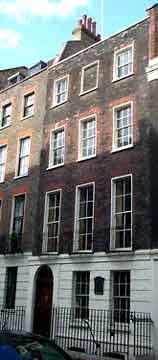|
|
 The American Connection
Benjamin Franklin - A London home
36, Craven St, WC2
 Benjamin Franklin's association with London lasted more than 50 years - a period in which the city saw him rise from a penniless journeyman printer to a statesman of international renown. Of several lodgings taken by him during his visits, only one remains - a terraced house which would have been quite new when he arrived there in 1757. Benjamin Franklin's association with London lasted more than 50 years - a period in which the city saw him rise from a penniless journeyman printer to a statesman of international renown. Of several lodgings taken by him during his visits, only one remains - a terraced house which would have been quite new when he arrived there in 1757.
Now a quiet backwater just off the Strand near Charing Cross, Craven Street had then been redeveloped as a fashionable area fit for the gentry. Enough of the 18th century buildings survive today to give an impression of its former grandeur, although the facades were altered in the Regency period.
While the interior of number 36 remains much as Franklin would have known it, from the outside, the house has nothing extraordinary to show. A plaque set into the front wall simply records his five-year residence there without any ceremony or explanation.
In fact, Franklin's mission when he came to England in 1757 formed a crucial part of the sequence of events which led to the American War of Independence. For Franklin, it was something of a Catch 22 situation. At that time, British colonies in the New World were still loyal to the crown so when the French and Indian Wars(1) broke out, the colonies raised taxes to help fund the British defence. Pennsylvania, though, was a Quaker stronghold and many refused to pay the tax on religious grounds. While he had great respect for the Quakers, Franklin suspected that major landholders were simply using this moral stance in order to preserve their profits. When reasonable argument failed, he found himself dispatched to petition King George II for the right to tax these 'proprietary' lands - that is, lands which had been granted to the founder of the colony, William Penn, seventy years before.
The house at Craven Street, then, was home to Franklin while he pressed and won his case on behalf of the Pennsylvania Assembly. His qualities as a statesman were so highly prized, that he was asked to stay on as chief representative of the American colonies.
Franklin returned to Craven Street - although to number 7, which has since been demolished - in 1764, again as the representative of Pennsylvania. Here he was visited by political leaders including William Pitt the elder and the Earl of Chatham. In one of his letters, he recorded how Chatham called one Sunday morning in 1775 and 'staid with me near two hours, his equipage waiting at the door, and being there while people were at church'. It was also during this eight-year tour of duty that Franklin was brought before the House of Commons to explain America's objections to the Stamp Act. Although the act was finally repealed, there were soon plans for new taxes on the colonies. He left England in 1775, certain that the result would be war.
(1) The struggle for control of the colonies of the New World resulted in a series of wars between the French and the British supported by their colonial and Native American allies. These became known as the French and Indian Wars.
* Number 36, Craven Street has recently been refurbished. It is due to open as a museum dedicated to Franklin's life and work in the near future.

Benjamin Franklin's house is only viewable from the street.
 Embankment (District, Circle, Bakerloo & Northern lines) Embankment (District, Circle, Bakerloo & Northern lines)
Copyright © Jan Collie 2002
Published by permission of the author.
All rights reserved. No reproduction, copy or transmission of this publication may be made without written permission.
| |
|